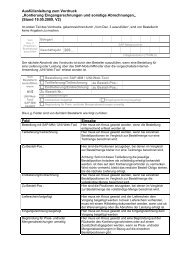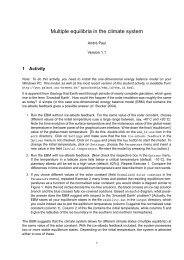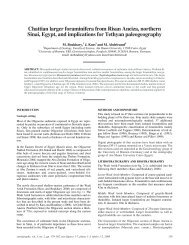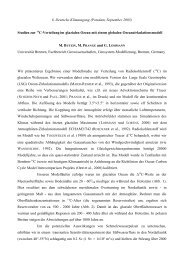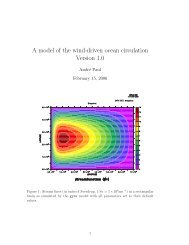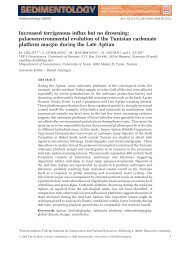Forschung im HLRN-Verbund 2011
Forschung im HLRN-Verbund 2011
Forschung im HLRN-Verbund 2011
- Keine Tags gefunden...
Erfolgreiche ePaper selbst erstellen
Machen Sie aus Ihren PDF Publikationen ein blätterbares Flipbook mit unserer einzigartigen Google optimierten e-Paper Software.
210Pushing the frontier of solvability of real-world opt<strong>im</strong>ization problemsDistributed branch-and-cut methods to solve previously intractable opt<strong>im</strong>izationinstancesM. Grötschel, Y. Shinano, Technische UniversitätBerlin, Zuse Institute BerlinAbstract• Opt<strong>im</strong>ization refers to finding the best solutionwith respect to objectives and constraints.• Mathematical opt<strong>im</strong>ization has proved that it cansolve instances which are so big that they seemto be unsolveable.• Big means that several million variables and constraintscan be handled efficiently.• In business terms, that refers to the possibility,for example, to solve problems in a finer decisiongranularity.• We solved two open instances of the problem libraryMIPLIB2003 [1] which is a collection of difficultreal-world opt<strong>im</strong>ization problem.Branch-and-bound is a very general and widelyused method to solve discrete opt<strong>im</strong>ization problems.Problem classes which can be solved (besidesothers) using this method are the class ofmixed integer programs (MIP), the class of mixedinteger nonlinear programs (MINLP), and the classof constraint integer programs (CIP). The challengeof these problems is to find one feasibleassignment to a set of decision variables whichyields a min<strong>im</strong>um/max<strong>im</strong>um value with respect toa given objective function. The feasibility regionfor these problems is described by side constraintswhich differ in their nature depending on the problemclass. In case of MIPs, for example, the sideconstraints are linear inequalities. In addition someof the variables are only allowed to take integer values,which makes these problems in general N P-hard.The idea of branching is to successively subdividethe given problem instance into smaller subproblemsuntil the individual subproblems are easyto solve. The best solution found in all these subproblemsyields a global opt<strong>im</strong>um. During thecourse of the algorithm, a branching tree is generatedin which each node represents one of thesubproblems. Usually, the vast majority of subopt<strong>im</strong>alnodes can be pruned by bounding at anearly stage. Therefore, mathematically sophisticatedtechniques are used to dramatically reducethe size of the branching tree and avoid a brute3 http://miplib.zib.deforce enumeration. Typically, problems with tenthousand variables and constraints (i.e., approx<strong>im</strong>ately2 10 000 potential solutions) can be solved byinvestigating a few hundred thousand branch-andboundnodes.In the first step we restrict ourselves to MIP instances,although our approach is much more generaland can also handle MINLPs, CIPs, satisfiabilitytesting (SAT) problems, pseudo-Boolean problems,and many more problem classes.State-of-the-art solvers for the problem classMIP are based on a branch-and-cut procedure,a mathematically involved variant of branch-andbound,in which the linear programming (LP) relaxationplays an <strong>im</strong>portant role. This relaxation isachieved by discarding the integrality conditions. Itcan be solved in polynomial t<strong>im</strong>e. The opt<strong>im</strong>al solutionvalue of the LP relaxation provides a dualbound for the original problem. This bound togetherwith the pr<strong>im</strong>al bound, the solution value ofthe best known solution, can be used for exampleto prune parts of the search tree or to prove (global)opt<strong>im</strong>ality in case the dual bound is equal to thepr<strong>im</strong>al bound.Mixed integer programming solvers have madetremendous progress in the last decades. For instance,the average algorithmic speedup in LP solutionsover the last 15 years is at least a factor of1000; another factor of 1000 comes from the hardwarespeedup, see Bixby [2]. For integer programmingeven more <strong>im</strong>pressive advances have beenachieved, see Bixby et al. [3]. The solvers havealso become numerically much more stable.One reason for this progress is the availabilityof real-world problem instances which are providedby different libraries. The most <strong>im</strong>portant one is theMIPLIB 3 . Since its introduction in 1992, the MIP-LIB has become a standard test set used to comparethe performance of mixed integer opt<strong>im</strong>izers.The MIPLIB contains a collection of difficult realworldinstances mostly from industrial applications.Its availability has provided an <strong>im</strong>portant st<strong>im</strong>ulusfor researchers in this area. The current version,MIPLIB2003, still contains six instances which resistedall attempts of the research community tosolve them to proven opt<strong>im</strong>ality.Within this project we focus on solving real-worldinstances which have up to now been intractabledue to insufficient computing power. Opt<strong>im</strong>al solutionsand the behavior of the solver (which is tapedMethodenentwicklung



